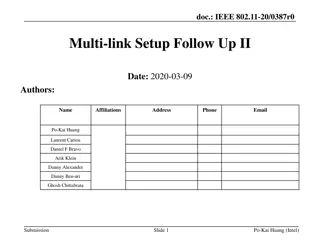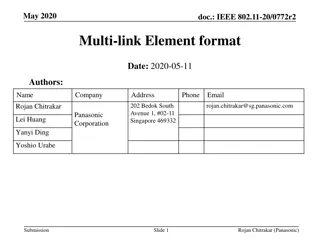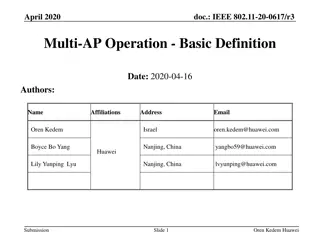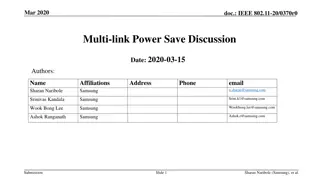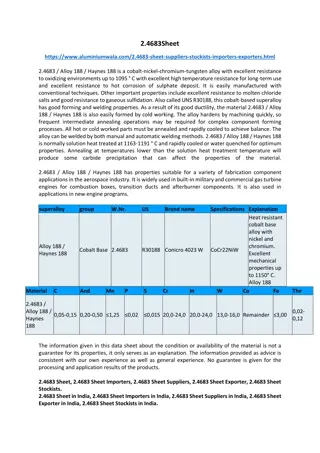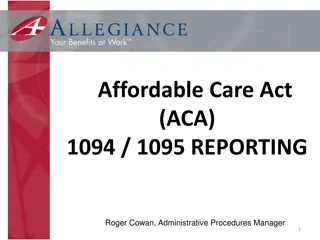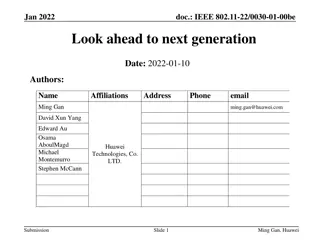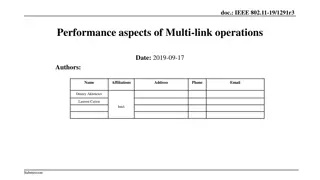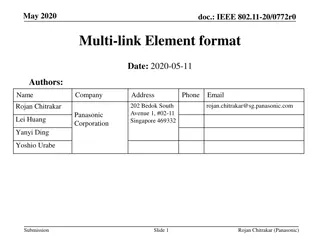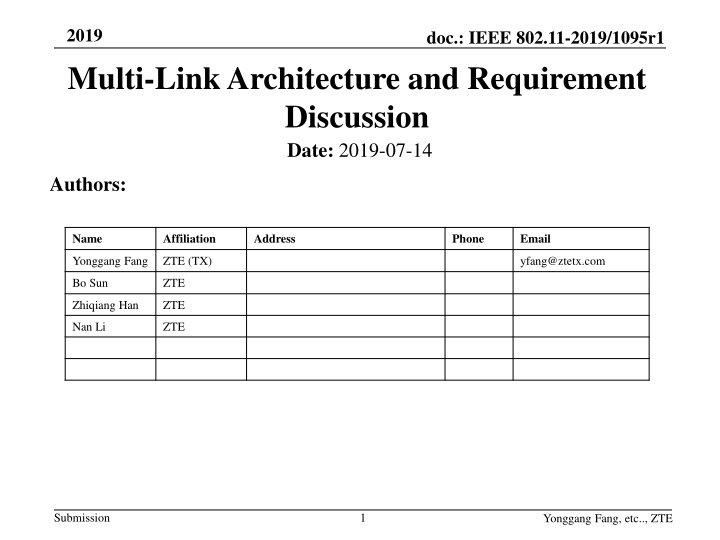
Multi-Link Architecture for High-Throughput Applications
This document discusses the potential of EHT multi-link communication to support applications requiring low latency, high reliability, and high throughput. It explores the background, potential applications, features, and considerations of multi-link architecture in IEEE 802.11-2019/1095r1 standard. The focus is on enhancing extreme high throughput for various use cases such as 4K/8K video transmission, virtual reality, IoT services, and more.
Download Presentation

Please find below an Image/Link to download the presentation.
The content on the website is provided AS IS for your information and personal use only. It may not be sold, licensed, or shared on other websites without obtaining consent from the author. If you encounter any issues during the download, it is possible that the publisher has removed the file from their server.
You are allowed to download the files provided on this website for personal or commercial use, subject to the condition that they are used lawfully. All files are the property of their respective owners.
The content on the website is provided AS IS for your information and personal use only. It may not be sold, licensed, or shared on other websites without obtaining consent from the author.
E N D
Presentation Transcript
2019 Multi-Link Architecture and Requirement Discussion Date: 2019-07-14 doc.: IEEE 802.11-2019/1095r1 Authors: Name Affiliation Address Phone Email Yonggang Fang ZTE (TX) yfang@ztetx.com Bo Sun ZTE Zhiqiang Han ZTE Nan Li ZTE Submission 1 Yonggang Fang, etc.., ZTE
2019 doc.: IEEE 802.11-2019/1095r1 Abstract This contribution discusses a potential EHT multi-link communication to support low latency, high reliability and high throughput applications. Submission 2 Yonggang Fang, etc.., ZTE
2019 doc.: IEEE 802.11-2019/1095r1 Background Potential Applications EHT PAR lists some major use cases for the specification enhancements Extreme high throughput 4K or 8K video transmission, virtual reality or augmented reality, remote office and cloud computing etc.. High reliability transmission application manufactory automation, IoT services, etc.. Low latency transmission application gaming, machine control, virtual reality or augmented reality, etc.. Submission 3 Yonggang Fang, etc.., ZTE
2019 doc.: IEEE 802.11-2019/1095r1 Background Potential Features EHT PAR lists some main features under the discussion for support indoor and outdoor operation in the 2.4 GHz, 5 GHz and 6 GHz frequency bands. 320MHz bandwidth and more efficient utilization of non-contiguous spectrum, Multi-band/multi-channel aggregation and operation, Multi-AP Coordination (e.g. coordinated and joint transmission), etc. The multi-channel and/or multi-AP operation may be considered together under the multi-link communication Multi-channel/band operation - when the multi-link communication are with the same AP. Multi-AP operation - when the multi-link communications are with different APs. Submission 4 Yonggang Fang, etc.., ZTE
2019 doc.: IEEE 802.11-2019/1095r1 Background 802.11 Protocol Reference Architecture Basic reference model Multi-band reference model MSDUs with same TID cannot be transmitted across channels or bands (A) ISO/IEC basic reference model (B) Reference model for a multi- band capable device Submission 5 Yonggang Fang, etc.., ZTE
2019 doc.: IEEE 802.11-2019/1095r1 Background 802.11 Protocol Reference Architecture Reference model for support multiple MAC sublayers (C) Reference model for supporting multiple MAC sublayers Submission 6 Yonggang Fang, etc.., ZTE
2019 doc.: IEEE 802.11-2019/1095r1 Multi-Link Architecture Considerations Multi-Link Framework Requirements Dynamic selecting and switching an operating link to address the use cases of reducing access latency for fast connection, balancing loads, etc.. Concurrent transmit or receive packets over multiple links to address the use cases of improving transmission reliability and increasing peak-throughput. Utilizing multi-link efficiently for power saving especially for stations Submission 7 Yonggang Fang, etc.., ZTE
2019 doc.: IEEE 802.11-2019/1095r1 Multi-Link Reference Modal (1) ML Multi-BSS Model A ML AP forms multiple BSS, each has its own link and operates independently. A ML STA associates with one or more BSS of the ML AP and communicates with the ML AP through each BSS. More backward-compatible to legacy reference architecture, and reuse of most existing MAC It may need multiple associations and is difficult for coordination of ML operations by the upper layer. MLME PME MLME PME CH1 802.11 MAC1-L 802.11 PHY1 802.11 MAC1 802.11 PHY1 Upper Layer Upper Layer CH2 802.11 MAC2-L 802.11 PHY2 802.11 MAC2 802.11 PHY2 CH3 802.11 MAC3-L 802.11 PHY3 802.11 MAC2 802.11 PHY2 ML STA ML AP Submission 8 Yonggang Fang, etc.., ZTE
2019 doc.: IEEE 802.11-2019/1095r1 Multi-Link Reference Modal (2) ML Single-BSS Model A ML AP forms a single BSS (i.e. BSSID) over multiple links A ML STA associates to this BSS of ML AP, but can communicate through different links. Single association and easy to control/coordinate the ML operation by MAC Some modification of reference architecture may be needed. PME MLME PME MLME 802.11 MAC1-L CH1 802.11 PHY1 802.11 MAC1-L 802.11 PHY1 CH2 802.11 MAC-U 802.11 MAC-U 802.11 MAC2-L 802.11 PHY2 802.11 MAC2-L 802.11 PHY2 CH3 802.11 MAC3-L 802.11 PHY3 802.11 MAC2-L 802.11 PHY2 ML AP ML STA Submission 9 Yonggang Fang, etc., ZTE
2019 doc.: IEEE 802.11-2019/1095r1 MAC Protocol Stack Partition Upper MAC vs Lower MAC TX RX MAC-U A-MSDU Aggregation A-MSDU De-aggregation PS Defer Queue (null) Sequence Number Assignment (null) MSDU Integrity Protection (optional) MSDU Integrity Protection (optional) Fragmentation Defragmentation Packet Number Assignment Replay Detection (optional) (null) Block Ack Buffering and Reordering MPDU Encryption and Integrity Protection MPDU Decryption and Integrity Check (null) Duplicate Removal (null) BA (delayed) TX1 TX2 RX1 RX2 MAC-L (null) (null) HARQ-ACK/NACK, ACK, BA HARQ-ACK/NACK, ACK, BA (null) (null) Address Filtering Address Filtering MPDU Header + CRC Creation MPDU Header + CRC Creation MPDU Header + CRC Validation MPDU Header + CRC Validation MPDU Aggregation MPDU Aggregation MPDU De-aggregation MPDU De-aggregation Submission 10 Yonggang Fang, etc., ZTE
2019 doc.: IEEE 802.11-2019/1095r1 Multi-Link Requirement Discussion Multi-Link Operation Options Selective communication Transmit or receive a PPDU over one link Joint communication Concurrently transmit or receive the same PPDU over two or more links Simplex communication Concurrently transmit or receive different PPDUs over two or more links Duplex communication Concurrently transmit and receive different PPDUs over two or more links Multi-Link Operation Setup ML STA and ML AP may need to exchange the ML capability during the association. Multi-Link Transmission Current MAC SAP only supports Service Class (SC): QoSAck and QoSNoAck It may need new SC : Low Latency, High Reliability and High Throughput Submission 11 Yonggang Fang, etc., ZTE
2019 doc.: IEEE 802.11-2019/1095r1 Multi-Link Requirement Discussion Support Low Latency Applications A STA performs EDCA on multiple channels to find the earliest available link(s) and transmits the low latency data packet over this link. The earliest available channel in the idle Transmits a PPDU over CH3 CH Busy CH3 CH Busy CH2 CH1 CH Busy Submission 12 Yonggang Fang, etc., ZTE
2019 doc.: IEEE 802.11-2019/1095r1 Multi-Link Requirement Discussion Support High Reliability Applications A STA performs EDCA on multiple channels to find two or more available link and transmits high reliable data packets jointly over those links. Two available channels at the same time CH3 transmit the same PPDU over CH3 CH Busy CH Busy CH2 CH1 transmit the same PPDU over CH1 CH Busy Submission 13 Yonggang Fang, etc., ZTE
2019 doc.: IEEE 802.11-2019/1095r1 Multi-Link Requirement Discussion Support High Throughput Applications A STA performs EDCA on multiple channels to find multiple available links and transmits high throughput data packets in simplex or duplex. The first available channel The third available channel CH3 CH Busy Transmit a PPDU over CH3 CH2 CH Busy Transmit a PPDU over CH2 CH Busy CH1 Transmit a PPDU over CH1 The second available channel Submission 14 Yonggang Fang, etc., ZTE
2019 doc.: IEEE 802.11-2019/1095r1 Summary In this contribution, we discussed Multi-Link reference modes and a potential MAC protocol model Multi-Link framework requirements Different Multi-Link operation options and how to use them to support different application use cases Submission 15 Yonggang Fang, etc., ZTE
2019 doc.: IEEE 802.11-2019/1095r1 Straw Poll 1 Do you support the single BSS (i.e. BSSID) over multi link operation? YES/NO/ABS Submission 16 Yonggang Fang, etc., ZTE
2019 doc.: IEEE 802.11-2019/1095r1 Straw Poll 2 Do you support ML STA and ML AP exchange their multi link capabilities during the association? YES/NO/ABS Submission 17 Yonggang Fang, etc., ZTE
2019 doc.: IEEE 802.11-2019/1095r1 Straw Poll 3 Do you support following options in Multi-Link Operation? A. Selective communication Transmit or receive one PPDU over one link at one time YES/NO/ABS A. Joint communication Concurrently transmit or receive the same PPDU over two or more links YES/NO/ABS B. Simplex communication Concurrently transmit or receive different PPDUs over two or more links YES/NO/ABS Submission 18 Yonggang Fang, etc., ZTE
2019 doc.: IEEE 802.11-2019/1095r1 References 1. 11-18-1231-04-0eht-eht-draft-proposed-par 2. 11-18-1233-04-0eht-eht-draft-proposed-csd Submission 19 Yonggang Fang, etc., ZTE
2019 doc.: IEEE 802.11-2019/1095r1 Thank you! Submission 20 Yonggang Fang, etc., ZTE

